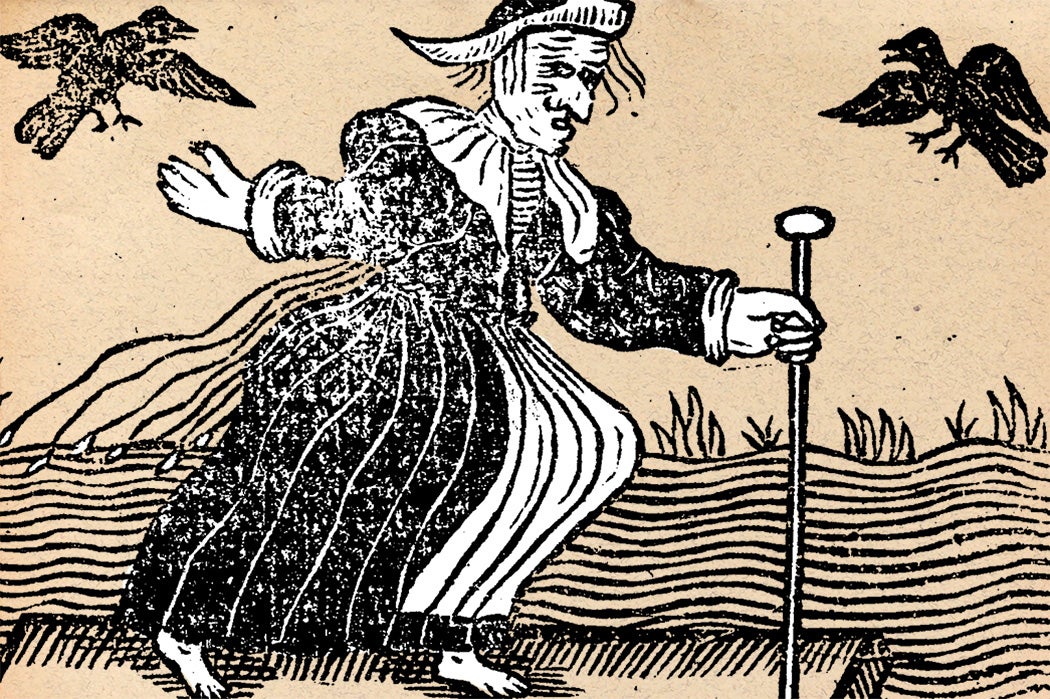The history of sexuality has a problem: the archive is often silent on the topic. When sex and sexuality are documented, they’re often filtered—or smothered—through what scholar Julia M. Garrett calls “enveloping discourses,” most notably law and religion, both of which were concerned with drawing boundaries between legal/moral and criminal/immoral sexuality.
One of these enveloping discourses is the early modern belief in witchcraft in Europe. Garrett explains that witchcraft trials have provided a wealth of documentation about the “pursuit of sexual knowledge” and have therefore come to have
a vital place within the history of sexuality. […] Witchcraft discourse provides a rich store of narratives that express erotic fantasies and anxieties, debate the workings of sexual anatomy, and offer a vocabulary for describing sexual deviance.
English history in particular presents a “startlingly explicit stain of discourse about the sexual body and the nature of erotic experience” in the “learned, judicial, popular, theatrical” discursive forms focused on witchcraft and demonology.
“The distinctively English judicial concern with searching a suspect’s body for a witch’s mark or a supernumerary teat […] provided a permissive, even urgent context for investigating women’s bodies and interrogation them about their erotic experiences.”
Garrett writes that English witchcraft trials were not as “lurid” as continental European ones. On the continent, torture produced “outlandish confessions” of “orgiastic sabbaths, copulation with the devil, transvection (nocturnal flight), violation of the dead, cannibalism, and ritual infanticide.” (Just another day in Calais, muses the Little Englander.)
English investigations, meanwhile, rarely used torture. Trial documentation is much less sensationalistic. There was an exception to the “relative tameness” of English witch trials, however. This was the body search for the witch’s mark (usually a supernumerary teat/extra nipple) or the devil’s mark (a brand or scar). After the mid-sixteenth century, the search for such marks—not always clearly defined or distinguished, but nevertheless taken as evidence of some kind of contractual union between witch and devil—was a wide-spread investigative technique in England.
The witch’s mark in particular was an English obsession. For accused women, it was typically a group of women who did the examination—in a time when women weren’t allowed on juries and there was no such thing as a female prosecutor. Often such groups included neighbors and/or relatives of both the accused and her accusers.
The most influential of witch-hunting manuals, Malleus maleficarum (1486), usually translated into English as Hammer of Witches, focused attention on the genitals as “the bodily site most vulnerable to demonic influence.” A supernumerary teat—through which familiars or the Devil himself were supposed to suck blood— was thus often found near or adjacent to the “fundament” or “privy place.” (Warts, pimples, skin tags, tumors, old scars, blemishes; almost anything could be interpreted as a mark of witchery.)
James VI of Scotland’s popular and influential Daemonologie (1597) provides a “unusually vivid and detailed drama of demonic seduction” and devil-marking, writes Garrett. (Yes, this was the same James who became James I of England, Scotland, and Ireland in 1603 upon succeeding his cousin, Queen Elizabeth I. He was also, the book testifies, quite knowledgeable about the ins and outs of human reproduction.)
Weekly Newsletter
The literal demonization of women’s sexuality meant a legally sanctioned undermining of the tradition of the female body as “both something that could not be known and something that could not be talked about.” In witch-hunting, it was imperative that the female body reveal its secrets and be talked about.
It was probably the relentless invasiveness of that imperative during the excesses of the East Anglia witch hunt of 1645–1647 that helped turn the tide against witch trials. As Garrett concludes,
“[w]hile witchcraft discourse provided a vital medium for sexual knowledge during the period of England’s witch trials, it is conceivable that sexual discourse may have helped to nourish the skepticism necessary to bring those trials to an end.”







